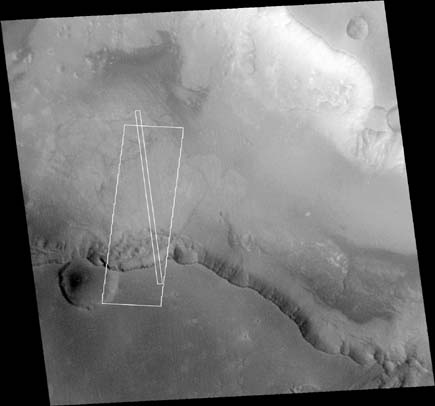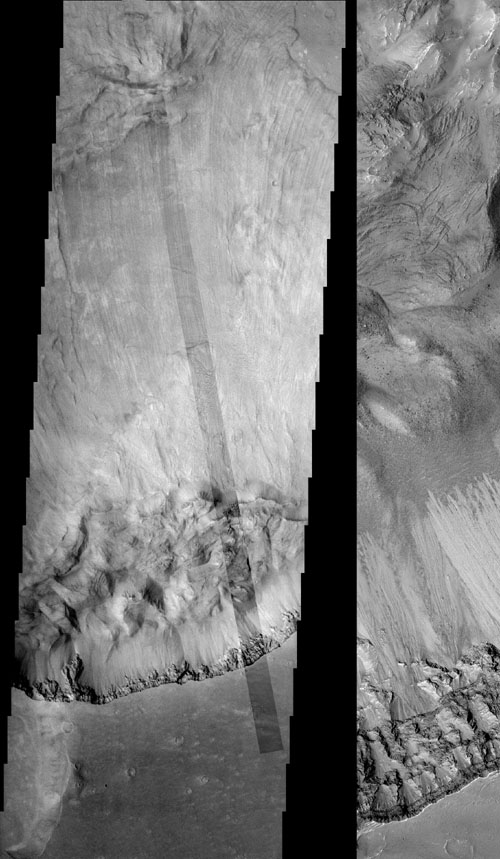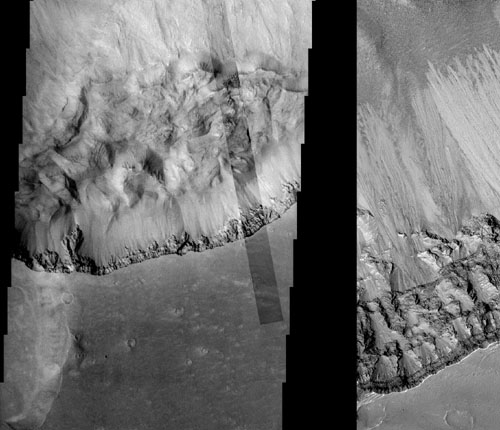TWO MSSS-BUILT CAMERAS NOW ORBITING, TAKING PICTURES OF MARS
After operating in Mars orbit for over four years, the Mars Orbiter Camera (MOC) has been joined by another Malin Space Science Systems (MSSS) imaging system, the Thermal Emission Imaging System (THEMIS) Visible Imaging Subsystem (VIS). As part of Mars Odyssey’s science payload, VIS was designed and built by MSSS under contract to Arizona State University, and integrated into the THEMIS instrument by Raytheon’s Santa Barbara Remote Sensing Group.
The MOC, part of the Mars Global Surveyor payload, consists of two separate imaging systems: the Wide Angle, which views the whole planet daily at typically 7.5 km/pixel and has a maximum resolution of about 230 meters per pixel, and the Narrow Angle, which takes image strips up to 3 km wide at as good as 1.4 meters per pixel. VIS takes a swath about 20 km wide at a resolution of about 20 meters per pixel.
A comparison between the two instruments is made in the figures below. VIS recently acquired a picture of a landslide in Ganges Chasma, part of the Valles Marineris canyon system. This feature had previously been imaged by MOC. Figure 1 shows Ganges Chasma as seen with the MOC Wide Angle camera. The larger white rectangle shows the coverage of the VIS image and the narrower rectangle shows the footprint of the MOC Narrow Angle picture.

Figure 2 shows both the VIS and MOC Ganges Chasma images. The picture on the left shows the VIS image with the MOC image overlaid. The right picture shows a section of that MOC image at its full resolution. Figure 3 shows a section of Figure 2, for easier reproduction.


“There’s always a trade-off between resolution and field of view in camera design”, said Dr. Michael Ravine, MSSS project manager for the VIS instrument development. “The MOC takes very high resolution images, but only over a field of view a couple of miles wide. Because the VIS has about one-tenth the resolution of the MOC, it can cover a swath six times wider. Over the course of the Mars Odyssey Mission, the VIS will be able to cover a hundred times the area the MOC has been able to cover, at much higher resolution than Viking.”
Malin Space Science Systems of San Diego, California, built the VIS under a $1.1M contract to Arizona State University of Tempe, Arizona. The VIS is operated by ASU. The MSSS team that developed the VIS includes the Kodak Image Sensor Solutions in Rochester, NY, which provided the charge-coupled device (CCD) detector for the instrument, and Ambitech International Axiom Operations of Beaverton, OR, which assembled the flight electronics boards. MSSS and the California Institute of Technology built the MOC using spare hardware from the Mars Observer mission, under a $3.5M contract to NASA’s Jet Propulsion Laboratory. MSSS operates the MOC from its facilities in San Diego.
If all goes well, VIS and MOC will be joined by two more MSSS cameras in 2006, when the Mars Reconnaissance Orbiter spacecraft arrives: the MARCI Wide Angle camera and the “context camera” or CTX. MARCI is a re-flight of a MSSS experiment lost when the Mars Climate Orbiter mission failed in 1999. It will image the entire planet at about 1 km/pixel resolution in five visible and two ultraviolet colors. CTX is a new camera design, capable of acquiring black and white swaths 30 km wide by many hundreds of km long at about 6 meters/pixel. This will allow much larger areas of the planet to be imaged at MOC-like resolution.
Malin Space Science Systems (MSSS) was established in 1990 to design, develop, and operate instruments to fly on robotic spacecraft. It built and operates the Mars Orbiter Camera on the Mars Global Surveyor spacecraft, and provided science instruments for the Mars Climate Orbiter, the Mars Polar Lander, the Mars Surveyor 2001 lander, and the Mars Odyssey orbiter. MSSS is also developing instruments for the Mars Reconnaissance Orbiter, to be launched in 2005. The ongoing activities of the company are described at www.msss.com.












 Copyright 2023 All rights reserved.
Copyright 2023 All rights reserved.